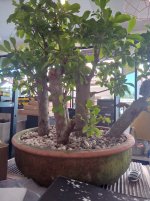marineman16
Seed
- Messages
- 4
- Reaction score
- 1
I have a large Ficus Retusa that has given me many, many smaller cuttings over the years, and I have a 90% or better survival rate on them. I simply shove them in some dirt and they grow, almost without fail.
I have been experimenting with some larger branches, up to 1" in diameter, and I'm finding my success rates are dropping very quickly. I've tried air-layering a couple times, but I'm trying to get it "down to a science" as to when a branch is too thick to cut and plant and air-layering should be the path forward.
Curious on other's experiences here.
I have been experimenting with some larger branches, up to 1" in diameter, and I'm finding my success rates are dropping very quickly. I've tried air-layering a couple times, but I'm trying to get it "down to a science" as to when a branch is too thick to cut and plant and air-layering should be the path forward.
Curious on other's experiences here.

